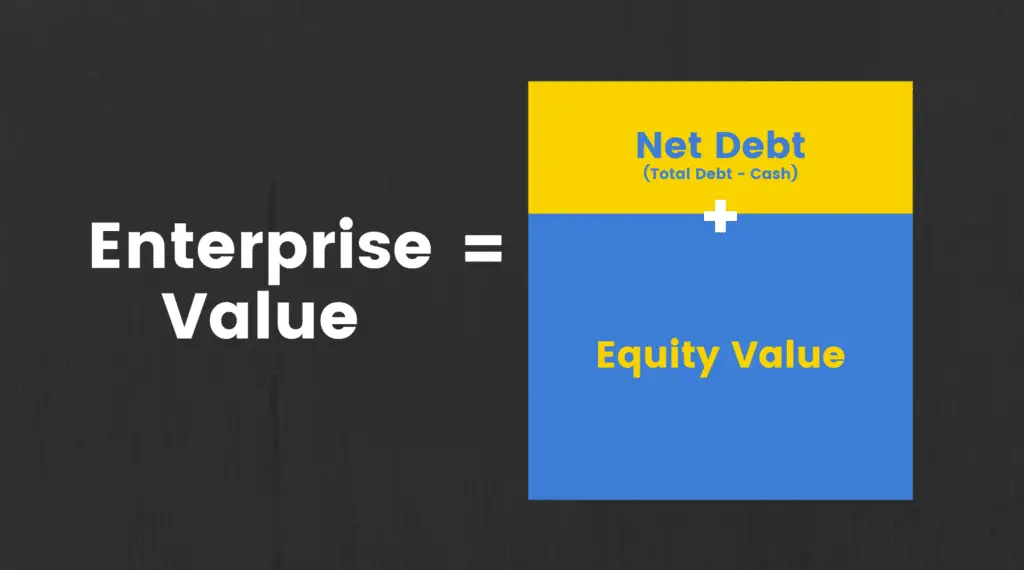This post may contain affiliate links, which means I’ll receive a commission if you purchase through my links, at no extra cost to you. Please read full disclosure for more information.
Free cash flow represents the amount of cash generated by a company after paying expenses to run the business and maintain capital assets. It is a measure of profitability to analyze the cash a company has on hand available to use freely. Hence the name “free cash flow.”
A company will use free cash flow for a number of things including paying down debt, issuing dividends, investing in itself by funding new operations and projects, and investing in itself by buying back its own shares.
Deciding what to use free cash flow on will come down to risk, return, and micro and macro circumstances. The ultimate goal is to maximize the value of the firm.
Most important thing to look at
Free cash flow is considered to be one of the most important financial metrics to look at in a business.
Many investors and analysts look at free cash flow over earnings and net income. Free cash flow is harder to manipulate than earnings are. Additionally, earnings take non-cash items into consideration and free cash flow does not. This metric only considers cash.
Because of those two traits, free cash flow is seen as a transparent metric to show the financial health of a company.
Free cash flow is cash that is available for discretionary use. Investors can look at free cash flow and draw a number of conclusions to make investment decisions. They will see free cash flow and ask themselves..
“How much cash does this company have to use for other purposes to bring value to shareholders?”
FREE CASH FLOW FORMULA AND CALCULATION

US GAAP does not require companies to report or disclose free cash flow. The result is that free cash flow isn’t easily laid out for the public to see. There isn’t a free cash flow line item in company filings. It has to be calculated and derived from a company’s financial statements.
One thing about free cash flow is that there are a few ways to compute it. We’ll begin with the easiest calculation:
- FCF = Cash Flow From Operations – Capital Expenditures
The variables to this calculation can be found on a company’s statement of cash flows. Simply find the line items for cash flow from operations and capital expenditures. You can also derive free cash flow using the income statement and the balance sheet.
Below is the second equation used to calculate free cash flow:
- FCF = Net Income + Depreciation/Amortization – Changes in Working Capital – Capital Expenditures
Example
Imagine that you know the following about ABC Company:

Using the first equation, you can quickly calculate free cash flow by subtracting capex from cash flow from operations.
FCF = $2,520 – $350 = $2,170
If you aren’t given the statement of cash flows, you can calculate FCF using items from the income statement and balance sheet. Using the second equation, the math would be the following:
FCF = $2,000 + $500 + $70 + $20 – $70 -$350 = $2,170
Both yield the same result.

Levered vs Unlevered Free Cash Flow
The two calculations above calculate what is called levered free cash flow. Levered free cash flow is cash flow that is available to equity investors.
The “levered” refers to the debt obligations. Levered free cash flow is calculated after the business has paid its obligations (ie it has paid its debt already). Since debt has already been paid, the remainder is left for equity investors.
A third calculation of free cash flow calculates unlevered free cash flow. Unlevered free cash flow is the cash flow available to both debt and equity holders. When unlevered free cash flow is calculated, financial obligations have not been paid yet.
- Unlevered FCF = EBIT (1-Tax Rate) + Depreciation/Amortization – Changes in Working Capital – Capital Expenditures
Note how this equation begins with EBIT rather than Net Income. The EBIT measure is earnings BEFORE interest and taxes.

Depreciation and Amortization
Depreciation and amortization are added back in to arrive at free cash flow because they are non-cash items.
Free cash flow is meant to show cash transactions happening now, not in the past. Although depreciation is expensed over the years, the money was already spent on the asset in the past.
BUSINESS USE OF FREE CASH FLOW FUNDS
Having free cash flow will enable the management of a company to use those funds for a variety of options to increase shareholder value, including:
- Paying down debt
- Issuing, maintaining, or growing dividends
- Buying back shares
- Expanding the business (ex: hiring more employees, increasing marketing spend, spending more on working capital, spending capex)
- Investing in other assets including securities and real estate
- Acquire other companies
Great management will weigh the options it has to best increase shareholder value while minimizing risk.
USE OF THE FREE CASH FLOW METRIC
Identify cash available
Free cash flow, as a metric, is looked at to identify how much discretionary cash a company has to use. Having a healthy amount of cash to put towards anything the company wishes is an advantage and could be an indicator of future earnings and value for shareholders.
Credit and risk
Creditors will look at free cash flow to determine if a company can pay down debt and/or take on new debt. A company with a large amount of cash flow will be less risky to lend to than a company that is low on free cash flow and could struggle making payments.
Free cash flow is analyzed in great detail by private equity firms conducting leveraged buyouts. Since target companies will be taking on a large amount of debt in a buyout, the ability to make debt payments is essential. Having a high free cash flow enables a company to make those high debt payments.
Valuation
Free cash flow is also used in valuation, such as a discounted cash flow (DCF) analysis. Investors also look at free cash flow per share over earnings per share for a more transparent ratio on financial performance
HOW TO ANALYZE FREE CASH FLOW

Trend analysis
Firstly, look at the trend of a company’s free cash flow over time to identify what has been happening year over year. Have free cash flows steadily gone up? Are they choppy? Are they trending downwards? Investors want to see stable cash flows trending upwards.
One-time items
One-time items or occurrences are things that are not part of the company’s main course of business but required an expenditure of cash.
One-time purchases of PP&E and other things can cause FCF to be lumpy, with some quarters of high free cash flow, and other quarters with low free cash flow due to the one-time event. To get a more accurate picture of free cash flow, you can add the expenditure for the one-time items back into free cash flow.
When you take away the effect of one-time items, you are left to analyze how cash flow changed based on the business itself.
Causes of FCF growth/decline
Investors need to identify the causes of FCF growth and decline. Seeing that free cash flow has gone up over time is not enough.
To make a more accurate assessment, look into why free cash flow has gone up. Have sales been growing/declining? Are expenses decreasing/increasing? Has the company spent too much/just right on capex? Answering these questions will help paint a better picture on the company’s performance.
Also, look to see if cash flows were affected by core business operations or non-operating items. Ideally, you would want a company’s rise in free cash flow to come from the business’s core operations.
It may be from great management by the company or free cash flows can be elevated by things like a decreased spend on inventory by the company or stretching out the payment
Past uses of FCF
Look at what a company has used free cash flow on in the past. How did those decisions turn out? Does management have a strong record of creating value for the shareholder?
Future plans for FCF
By listening in on earnings calls and reading through investor relations materials, you can get an idea of what the company plans on using FCF for in the future. Do the plans make sense? Does the company have the required amount of cash flow to fund its plans?
More is not always better
A large amount of free cash flow is not always better. This could mean that the company is sitting on too much cash and not putting that cash to use. Cash can only earn a small amount of interest sitting still in accounts.
To increase shareholder value, cash needs to be allocated and put to work. There is a balance to having free cash flow available and allocating cash.
Credit
Does the company have the free cash flow to pay down debt and/or take on new debt?
FCF vs valuation
If free cash flow is high and increasing and the company’s valuation is low, it could signal an investment opportunity. The opposite holds true as well. A overpriced valuation with low diminishing cash flows would be an unattractive investment unless you were shorting the company.
FCF vs Earnings
Look at the difference between net income and free cash flow. It is a good sign when they are relatively close to each other. For some companies, the differences can be major. Some companies may have solid earnings and little to no free cash flow. All their cash flow might be used to maintain capital assets.
BUSINESS ACTIVITIES THAT CAUSE FCF FLUCTUATIONS
The following business activities cause cash flows to increase or decrease. Activities like these should be kept in mind when evaluating cash flow to identify if changes in cash flows are organic and sustainable.
- Foregoing a dividend
- Selling major assets
- Shortening accounts receivable collections
- Lengthening accounts payable payments
- Cutting down capital expenditures
- Cutting back maintenance expenditures
- Delaying the purchasing of inventory
BENEFITS OF FREE CASH FLOW (FCF) METRIC

Transparency to financial health
Free cash flow is as transparent as you can get with a financial metric to judge a company’s financial health. Free cash flow is the amount of cash left AFTER a company has paid the expenses of running its business.
If that available cash amount is large, it shows the company is doing well from a financial standpoint.
Insight into fundamental trends
Additionally, the free cash flow metric and its components can be dissected to identify fundamental trends happening in a business. Things such as capex going down, accounts payable going up, and inventory going down can give insight on the underlying business.
Not skewed by non-cash expenses
A great thing about free cash flow is that it doesn’t account for non-cash items such as depreciation and amortization. It only considers actual cash transactions.
Valuation uses
Free cash flow is useful for valuation purposes. It is the key metric in finding intrinsic value using the discounted cash flow (DCF) analysis.
LIMITATIONS OF FREE CASH FLOW (FCF) METRIC

Can cause lumpy results
With capital expenditures and one-time items, free cash flow can end up looking lumpy quarter over quarter. Cash flows may be steady and then dip significantly when a company purchases a large amount of PP&E.
While this is limiting, investors can add back those costs for a more normalized view of free cash flow.
No required disclosure
Free cash flow is not required to be disclosed by public companies. This makes the metric slightly harder to track down. While the calculations aren’t too difficult, free cash flow ends up being calculated in a variety of methods, which can make comparisons more difficult.
Capex classification
To add to the difficult comparisons, different companies and industries may have different opinions on what is or is not considered capex. This can lead to an apples to oranges comparison between two companies.
Not completely immune to manipulation
Free cash flow is praised for being a transparent metric that isn’t subject to manipulation. This is true for the most part when you compare it to net income, but it is not completely immune.
Management can manipulate free cash flow through business activities. For example, a company can boost free cash flow by lengthening the amount of time they have to pay bills, shortening the amount of time they collect on payments owed, and delaying the ordering of new inventory.
These would all boost free cash flow in the short term, but would not be sustainable. You ultimately want to determine what the organic growth or decline of free cash flow is caused by.
SUMMARY
Free cash flow is seen as one of the most important financial metrics for investors and analysts to look it.
Cash flow is the amount of cash a business (and its shareholders) can keep or receive value from. Companies that have rising and stable free cash flow will have options to deploy capital and earn more.
Investors know this and see cash flow as a foreshadowing to future earnings and value. Free cash flow can be dissected and analyzed in a variety of ways to uncover aspects of the underlying business.
It is important for students, professionals, and investors to understand what free cash flow is, how it is calculated, and what it can be used for.



